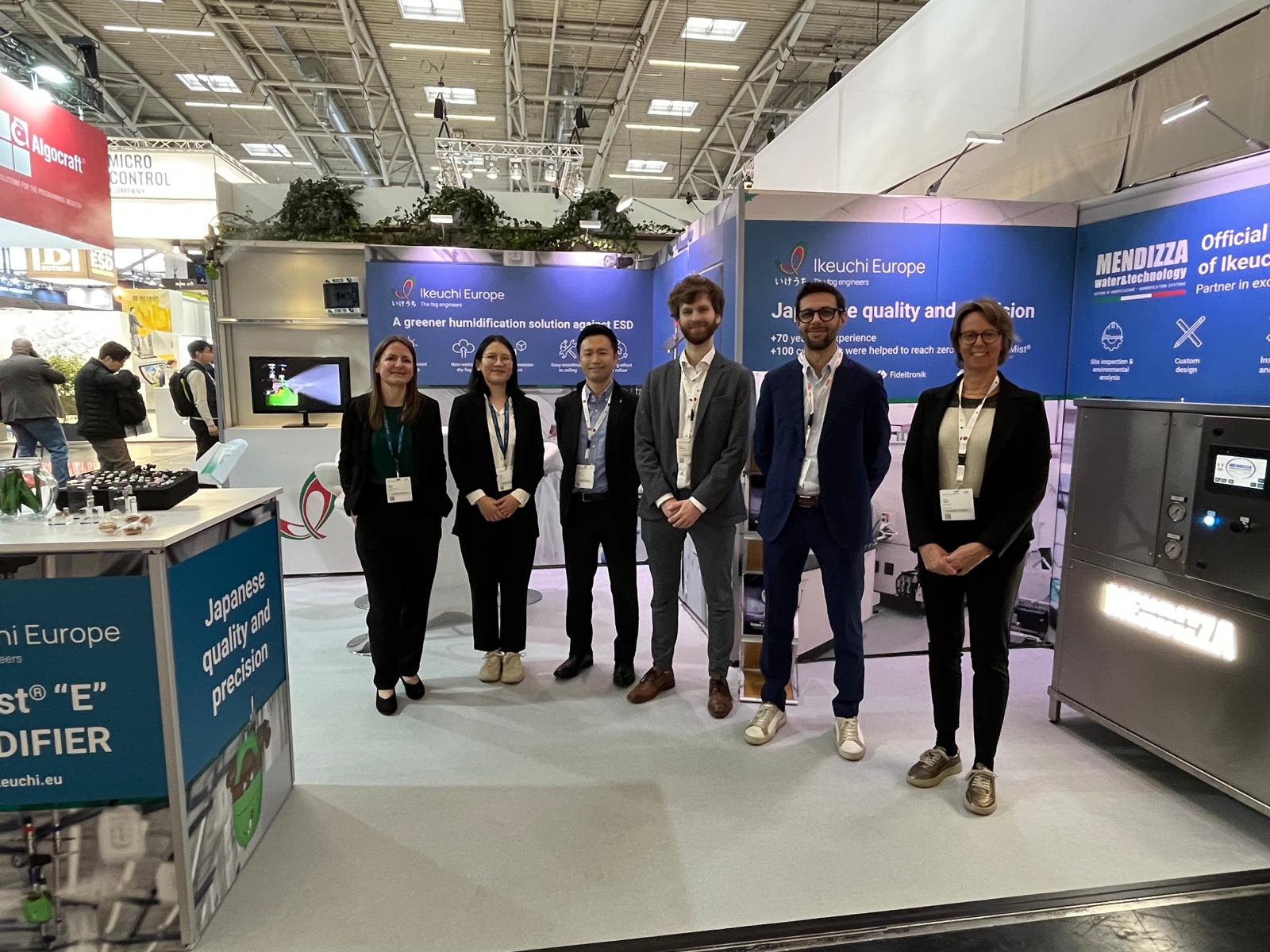Electrostatic electricity
Electrostatic discharge and their damages (from electrostatic breakdown) are a major problem for industrial manufacturing processes. Not only it can damage the production and machines, it also endangers workers.
Mechanism
Electrostatic breakdown is a phenomenon in which electronic components such as integrated circuits (ICs) are destroyed by static electricity. Damages by static electricity occur due to high voltage temporarily flowing through the ICs coming from an electrostatic discharge.
When ESD happens, a thin film (insulating layer) such as highly insulating silicon oxide is broken on the ICs. Therefore, the circuit inside is destroyed.
In recent years, electronic components have become lighter and smaller. Therefore, their sensitivity to static electricity has also increased.
In particular, metal–oxide–semiconductor (MOS) lose their function as semiconductors when only a voltage of about 80 to 100 V is applied.
Electrostatic shock
Electrostatic shocks can be detrimental to delicate semiconductor devices, even at relatively low voltages. To give an indication, humans can feel the pain from an electrostatic shock when the voltage is only about 3 kV. This gives you an idea of how small the voltage is and yet still it can damage the production of semiconductors.
Nowadays, as semiconductor devices become finer and more complex circuits, the wiring spacing (the size of the elements themselves) also becomes smaller. So their electrostatic resistance becomes lower. In some cases, such as when the oxide film is incomplete, it can even be destroyed at lower voltages. That is why more sophisticated measures for managing static electricity are required from manufacturers.
Semiconductors
Here are some examples of common damages due to electrostatic breakdown from electrostatic discharge, related to the semiconductors:
When peeling off wafer rack: Due to exfoliation charging that occurs during wafer transfer and removal from the wafer rack.
When peeling the protective film from the substrate. Electrification occurs when a protective film is peeled from a liquid crystal glass substrate.
Sheet peeling during chip mounting: Due to peeling electrification that occurs when chips are picked from a wafer sheet.
Charged objects that cause electrostatic breakdown Workers, equipment, and the semiconductor element itself can be considered as charged objects that cause electrostatic breakdown. In order to implement the correct solution to prevent ESD, there are 3 existing ESD test models:
When a charged worker carelessly brings a finger close to a semiconductor element. (Because humans move around and perform various tasks, they are extremely easily charged.)
The device is charged when the device comes into contact with the charged conductor and the device is grounded, causing electrostatic breakdown.
The circuit of a semiconductor device is charged, and is discharged when a terminal of the device approaches a nearby conductor. This causes electrostatic breakdown in an internal circuit.
1. Human body charging model (HBM)
The device is charged due to discharge when an electrostatically charged person touches the lead of the device. And when the device is grounded, a discharge current flows through the circuit, causing electrostatic breakdown.
The amount of charge released from the charged human body is large, and the discharge energy is extremely large compared to the case of an insulator.
2. Machine model (MM)
If the electrostatically charged object is a device, it is called a “machine model”. If the equipment used in the manufacturing process is not grounded, the conductors will also become charged. Then, when the charged body touches the external terminal of the semiconductor device, electric current penetrates through the device and causes electrostatic breakdown.
3. Charged device model (CDM)
Even if human body models and machine models are adequately protected against static electricity, there is a possibility that ESD induced destruction will occur during the production and assembly of semiconductor devices.
This is due to electrostatic discharge damage when the device itself is charged, and is called “device charging model”. In this discharge model, the device itself is charged by friction on the surface of the semiconductor device. As a result, conductors such as circuits and leads cause electrostatic induction by an external electric field. In this state, if the lead is grounded, the internal electric field will change abruptly and the discharge current will flow, causing electrostatic breakdown.
How can Ikeuchi help
As mentioned, electronics components are becoming smaller and smaller. Therefore, more sophisticated measures are required to help manufacturers preventing electrostatic breakdown damages on their production.
We have researched the optimal solution to prevent electrostatic discharge (ESD), by adding humidity in a working environment. Our non-wetting Dry Fog humidifier offers the adequate solution for sensitive working stations.
How can humidity control prevent electrostatic breakdowns
- Prevent ESD when peeling off wafer rack
- Prevent ESD when peeling the film from the substrate
- Prevent ESD from sheet peeling during chip mounting
- Prevent integrated circuits from being destroyed
- Prevent damage to machinery
Our humidification solution; AKIMist® Dry Fog Humidifier
The optimal environment to prevent static charge is when there is a high level of moisture, like in a bathroom. Static electricity will escape into the atmosphere through the moisture without accumulating and charging itself on the surface of the objects. That is why we recommend a humidification system to increase the amount of moisture contained in the air (absolute humidity).
Our AKIMist® humidifier, is a unique Japanese invention by Ikeuchi Japan, which offers full control of the humidity levels in a factory. It is an adiabatic humidifier, which means that it increases humidity by adding cold water to the air. AKIMist is known for its non-wetting abilities as the droplet size is less than 7.5μm. This means that the droplets are so small that they will bounce back without bursting on any surface. No risk of leakage or condensation. This is a very convenient ability in a factory with expensive machinery and materials which cannot get exposed to water or condense.
The AKIMist® “E” humidifier system provides a complete solution for ESD prevention. It is a total humidification system which can control the precise humidity level wanted with the installation of a sensor to the control panel.
AKIMist® “E” Dry Fog Humidifier
Our AKIMist®“E” spreads a Dry Fog that humidifies indoor environments without wetting due to its tiny droplet size around 7.5µm
Why is AKIMist® the most energy and cost efficient solution
The AKIMist®“E” running costs are five times lower than a steam humidification system, whether in water or energy.
Because it cools the room by 2℃ through evaporative cooling, it allows substantial HVAC energy savings.
It has very high efficiency for low maintenance costs.
catalog
Download our AKIMist® catalog to learn more about the unique technology behind dry fog
Related articles
Stay updated: Ikeuchi news & insights
"*" indicates required fields
Get expert advice:
contact us today
Would you like to know what Ikeuchi can do for your organization? We’re happy to discuss your needs and show how we can solve your challenges. You’ll receive a response from us within 24 hours!
"*" indicates required fields
Call us: +31 (0) 20 820 2175
- Global presence and experience
- The number 1 nozzle manufacturer in Japan
- Japanese Precision Technology
“High quality nozzles. Friendly and helpful customer service”
“With Ikeuchi spray nozzles we are able to save costs as we don’t need to replace them so often as before.”
“When it is about nozzle technology, IKEUCHI are the experts. We always highly appreciated their knowhow and their extremely wide range of nozzles, not to mention their unrivalled AKIMist humidifier”
“When it is about nozzle technology, IKEUCHI are the experts. ”




